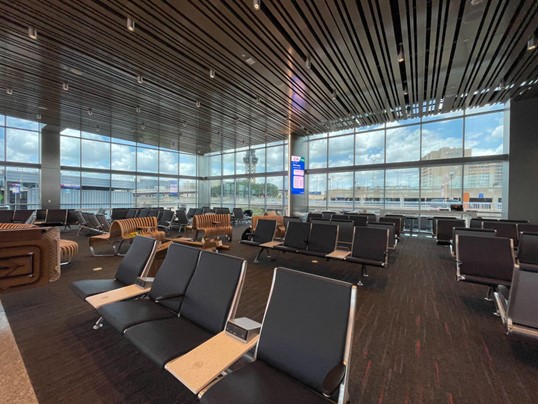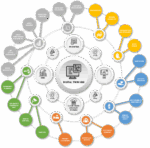
Now’s the Time for Digital Transformation in Aviation: External Pressures, Internal Obstacles, and Vital Technology to Adopt
Did you know that, on average, 23 million people walk through airports every day?
Yep, that equates to 8.6 billion (with a B) people in 2024.
Can you imagine the logistical coordination it takes to make sure each and every passenger gets to the right gate at the right time? For airport owners and operators, this is a daily reality… and the challenge is only growing: ACI World estimates that global passenger traffic will reach 9.4B this year.
This means a lot of opportunity: Post-pandemic, we’ve seen a renewed interest in travel. Coupled with the Bipartisan Infrastructure Law providing $15 billion in airport funding, this makes it the perfect time for airports to capitalize on the surge in travelers and invest in new technology that’ll optimize their operations for the long haul.
But it’s not all upside: Airports also face increased pressure to innovate—particularly from ESG requirements and escalating expectations against privatized competition.
Essentially, aviation owners have a vital choice. They can lean into digital transformation and become the kind of airport other airports look up to, or they can get tangled in the weeds of red tape, maintain dated practices, and fall behind. I’m writing this article to convince airport owners to choose the former.
First, let’s clarify the factors that make this problem more urgent than ever. Then, we’ll talk about specific technologies that can create the largest impact. And finally, we’ll review some obstacles to consider in making this journey.
External Pressures Influencing Aviation Transformation
On top of the innate desire to stay current and improve from within, most owners in the aviation space are feeling pressure (as they should) for two main reasons: rising ESG expectations and a significant trend toward airport privatization.
ESG Commitments
Air travel is a known culprit of carbon emissions and climate change. While decarbonization efforts and net-zero emission goals are an obvious focus, ESG efforts truly take root when the entire airport ecosystem is focused on social responsibility from the beginning stages.
Building information modeling (BIM) already yields dividends for some of America’s busiest airports. BIM solutions have optimized the design and construction process of some of the nation’s most complex aviation ESG projects at high-profile airports like LaGuardia, O’Hare, and Denver. These innovative owners have implemented technology that:
- Tracks and optimizes materials and equipment
- Transitioned formerly all-paper processes to all-digital practices
- Encourages clients to capture and reuse elements such as water, wind, and solar
For example, when the Pittsburgh International Airport recently demolished a portion of its airport to build a new terminal, the team reused demo’ed rock to create new roads and set up a new microgrid powered by on-site natural gas wells and solar energy to fully power the airport. (Curious about return on investment? That microgrid has saved them $1M in its first year alone.)
Meanwhile, the Dallas Fort Worth International Airport installed View’s smart glass in select terminals to monitor energy and keep indoor temperatures cool on those blisteringly hot Texas days. Not only is smart glass keeping terminals 15 degrees cooler and therefore using less energy, but according to a press release by View, smart glass is a passive crowd-pleaser. “Passengers who boarded at gates with smart glass were 68% more likely to report a higher satisfaction rate and rated the airport as 33% more modern, efficient, bright, and comfortable.”

The key is to think about ESG not as a regulatory box to check, but as an opportunity to do two things:
- Lean on technology in a way where you can actually understand your environmental impact
- Set yourself up for long-term success, as rising generations are more environmentally conscious than ever and want concrete answers about your environmental practices
There’s no question that the latest technology can aid in sensing and metering equipment within airport central utility plants, serving to fulfill external ESG requirements while also benefiting the bottom line.
Airport Privatization
The second external pressure impacting the speed of aviation innovation across the board is increased privatization of the industry. Although airports have traditionally been run by public and governmental entities, that’s changing quickly.
Private Equity (PE) groups, in particular, are buying up airports and making aggressive investments in improving efficiency and performance. This creates increased pressure on traditionally owned airports to keep up.
One recent study saw a substantial increase in efficiency for airports that have been privatized through a PE purchase:
- Overall Passenger Traffic rose 84% at PE-owned airports, vs. government-owned airports
- Freight Volume and Number of Flights also increased ~80% at PE-owned airports, vs. their government-owned counterparts
- Passengers Per Flight increased by an average of 20%, when government-owned airports were purchased by PE funds
With this level of increased competition, investing in innovation and technology adoption is no longer optional—these are the new table stakes required to operate in the aviation industry.
Vital Technology to Consider Adopting
Given these circumstances, the need to adapt is undeniable. But what should you actually be doing? What are the key areas to consider investing in?
Here are the four leading technologies you should consider implementing, if you want to keep up.
1. Digitized Documentation
Digitization is business-speak for “use less paper.” Instead of keeping operations and maintenance manuals in three-ring binders, put them in the cloud. Not only does digitizing save paper and aid in ESG goals, but it also makes it simple to update documents without having to reprint or track down the latest version.
2. Data Optimization
Collecting data means nothing unless you can make better decisions because you have that data. It has to be actionable. Emerging technology can consolidate data from multiple places, visualize it, and then analyze trends to make predictions.
For example, a building management system (BMS) in one airport terminal should connect with (or be the same as) the BMS in another terminal so you can track consolidated data on a single software platform without needing access to the machinery itself.
Pro tip here: The best BIM software that focuses on predictive maintenance. When equipment data is properly tracked, you can develop benchmarks to make sure you don’t over-tax your equipment.
3. Maximized BIM, plus Digital Twin Technology
The AEC industry has used BIM for decades to streamline project design and construction for the aviation industry. The process begins with the creation of an intelligent 3D model and enables document management, coordination, and simulation during the entire lifecycle of a project. By visualizing the project in a digital environment, it’s easy to detect potential conflicts and design inefficiencies and resolve them before construction, which minimizes delays and cost overruns.
When you can build things virtually before you build them physically, you gain efficiency and save on both human labor and material costs. Instead of having 10 people on-site building something for your airport, BIM allows you to build it off-site with a smaller team and bring it to the site already built.
BIM specialists work with aviation clients to provide them with virtual simulations and data-rich models that help them better predict:
- Cost
- Timeline
- Sequencing
- Sustainability
- Facilities management
- Operations data
The result? Better decision-making and stronger collaboration between everyone, from general contractors to transportation agencies.
To take things one step further, you could also consider Digital Twin technology to optimize your operations within BIM. A Digital Twin is an exact digital representation of a physical environment that acts as a connection between the digital and physical world, enabling data-driven insights and action.
A Foundational Twin might give you information like, “There’s a heating duct in an airport lounge,” whereas a slightly more sophisticated Integrated Twin might tell you, “The lounge is heating up because the thermostat is broken.” There are ways with this technology to start small and gradually scale up to see even more value.
4. Virtual Reality and Augmented Reality
If you want to take the visualization benefits of BIM to the next level, consider virtual and augmented reality. Where BIM impacts design and construction and Digital Twins impact operations, VR/AR technology heavily impacts employees. Being able to train employees in a virtual environment is powerful; you can onboard multiple staffers in a virtual world instead of one at a time on a physical piece of equipment.
Look for a partner with a VR/AR Studio and a team of artists, software developers, architects, and technologists who can craft realistic and immersive experiences, including architectural visualizations and interactive problem-solving simulations.
I’m convinced this is the future of technological excellence in aviation.
But, of course, digital progress always comes with its own share of hurdles to jump over. There are a few of the obstacles to tech adoption we typically see within the aviation industry.
Internal Obstacles Impacting Digital Progress
Airport construction is a legacy industry that’s broad and complex, so it’s no surprise that airports have been slower to progress along the digital maturity curve compared to other industries.
To pave the critical inroads you need to drive internal technology adoption, multiple decision-makers need to align and establish clear ownership of goals and budgets. There needs to be a thoughtful change management strategy, too, that’s communicated from the top down. Let’s look closely at the most common internal obstacles I’ve noticed lately.
Too Many Decision Makers
From the outside looking in, an airport seems like a single entity, but you and I both know it’s really an ecosystem of several vital players and decision-makers, including:
- Airport operators
- Airlines
- Airport authorities
Aviation owners and board members alike are keen on using technology to improve the customer experience and influence internal workflows, but there’s red tape everywhere.
Implementing innovation that impacts all three of these layers takes a concerted effort. Just because an airport owner or operator is interested in a new technology or service does not mean the airlines are. Similarly, the C-suite may be ready to sign off on new plans, but they’re likely not fully aware of what’s happening in the weeds at the operating level.
Validating the need for new technology initiatives has to happen across multiple channels. Be sure any new solution you propose doesn’t compete or overlap with existing solutions, and secure alignment across all three levels.
Budget Allocation Complexity
Budgets can be contentious in any industry — unless the projects are clearly validated.
Take the Los Angeles International Airport: LAX recently secured $30 billion to prepare for the 2028 Summer Olympics. It’s a staggering sum, but the decision to invest was easy when paired with the enormous economic value that the Olympics will bring to California and the U.S. as a whole.
Funding is rarely the issue for large airports. It’s the allocation of money that’s tricky for owners. This is where I’ve seen the value of education play out. Owners benefit from thought partners who can help them understand the ROI of one potential technical investment over another.
Lack of Technology Champions
Once internal alignment and budget are secured, you also need champions who will see the project through from inception to completion. It’s not enough to have enthusiastic, but distant support for a project; you also need ownership and follow-through from key players within the airport’s operation.
Internal technology champions are the people on the inside who:
- Have a strong belief in a technology’s potential
- Are willing to adopt it early
- Are prepared to enable others to adopt it as well
These champions have the unique task of communicating and validating both up and down — up to the board of directors and down to the employees on the ground who will be responsible for implementing new software or procedures.
Change Management
Change management is arguably the most important (and challenging) piece of the digital transformation puzzle.
Operators and facility managers might be loyal to legacy systems and processes, or be wary that technology will eliminate their jobs. Change management is the process of alleviating fears and helping employees see — and bridge — the gap between the airport’s current state and future vision.
This includes making clear that new technology is there to assist rather than replace employees. You’ll want to go beyond hosting training sessions to teach employees to use new tech, but rather make yourself or your team available for conversations that give them a sense of input and ownership over new software and processes. Not only will this ensure tech is adopted faster, but it will reduce the potential turnover of disgruntled staff.
Prepare for Successful Digital Transformation
A clear digital strategy and roadmap make any digital undertaking more manageable, especially if your initial goal is as high-level as “modernize my airport.”
VIATechnik works with renowned aviation clients to understand what operations, resources, workflows, and standards currently exist — and then advises them on which new technology would make their vision for the future a reality.
No matter which partner you work with though, know this: You want a strong working relationship built on trust, and you want to act fast. Even if you’re itching to invest in technology today after reading this, take the time to choose the right approach with the right partner to ensure adoption and success both take flight.
If you need a hand with your airport’s digital transformation and aren’t sure where to start, we’d love to meet you. Contact our team at VIATechnik today.



